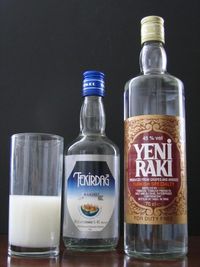Rakı
Raki Turkish Rakı,[1] pronounced [raˈkɯ]) is a non-sweet, anise-flavored spirit popularly consumed in Turkey, Bosnia and the rest of the Balkans as an apéritif, in particular alongside seafood and mezze.
Raki is traditionally produced by twice-distilling either pure suma or suma that has been mixed with ethanol in traditional copper alembics of 5000 litres (1320 US gallon, 1100 UK gallon), and subsequently flavoring with aniseed.[2] It is similar to several kinds of alcoholic beverages available around the Mediterranean, Middle East, and Colombia, including pastis, ouzo, sambuca, arak, anise castellano, and aguardiente. In the Balkans, however, "raki" refers to a non-anise-flavored drink made from distilled pomace, similar to Italian grappa, Greek tsipouro, Cretan tsikoudia, Cypriot zivania and Spanish orujo.[3]
In Turkey, raki is the national drink, and is traditionally consumed either sec with chilled water on the side, or partly mixed with chilled water, according to personal preference. The subsequent dilution causes Raki to turn a milky-white colour, similar to the louche of absinthe or what is observed in the ouzo effect. This phenomenon has resulted in the drink being popularly referred to aslan sütü, literally meaning "lion's milk", which, together with the usage of the word aslan (tr. lion) as a Turkish colloquial metaphor for a strong, courageous man, gives the term a meaning close to "the milk of the brave". Ice cubes may be added, if desired, to diluted raki, since the anise in undiluted Raki tends to quickly crystallize.
Raki is commonly consumed alongside mezze -a selection of hot and cold traditional appetisers-, and is especially popular alongside seafood, together with fresh arugula, white cheese and melon.
Raki is an equally popular complement to various red meat dishes like kebabs, where it is consumed either with a glass of Şalgam.
Contents |
Etymology
The term raki entered English from Turkish rakı.[1] The word rakı is derived from the Arabic عرق [ʕaraq], other variants being araka, araki, ariki.[3] Araq means perspiration in Arabic,[4] which is believed to methaporically refer to condensation,[4] which likely refers to the condensation that forms outside of the chilled glass, the drop-by-drop manner in which Raki is distilled that is reminiscent of sweating, or the phenomenon of unexpected sweating observed in individuals engaging in excessive Raki consumption.[3] Raki is sometimes referred to as "Lion's Milk" [1].
History
In the Ottoman Empire, until the 19th century, meyhanes run by Greeks and Albanians[5] would mainly serve wine along with meze, due to religious restrictions imposed by various Sultans. Although there were many Muslims among meyhane attendants, sharia authorities could, at times, prosecute them. With the relatively liberal atmosphere of the Tanzimat Period (1839–1876), meyhane attendance among Muslims rose considerably, and Raki became a favourite among meyhane-goers. By the end of the century, Raki took its current standard form and its consumption surpassed that of wine.
During this period, Rakı was produced by distillation of grapes pomace (cibre) obtained during wine fermentation. When the amount of pomace was not sufficient, alcohol imported from Europe would be added. If anise was not added, it would take the name Düz Rakı (Straight Raki), whereas Raki prepared with the addition of gum mastic was named Sakız Rakısı (Gum Raki) or Mastika, especially if produced on the island of Tenedos.
With the collapse of the Ottoman Empire and the establishment of the modern-day Republic of Turkey, grape-based Rakı began to be distilled by the state-owned spirits monopoly Tekel (literally meaning "single-hand" or "Monopoly"), with the first factory production taking place in 1944 in Izmir. With increasing sugar beet production, Tekel also began to distill the alcohol from molasses, and a new brand of Raki made from sugar-beet alcohol was introduced under the name Yeni Rakı (literally "New Rakı"). Molasses gave this new Rakı a distinctive bitter taste and helped increase the drink's popularity.
Today, with increased competition from the private sector, and the privatisation of Tekel in 2004, several new brands and types of Raki have emerged, each with its own distinct composition and production method, although the overall qualities of the drink have generally been kept consistent. These include Efe Rakı, Çilingir Rakı, Mercan Rakı, Fasıl Rakı, Burgaz Rakı, Ata Rakı, and Anadolu Rakı. Sarı Zeybek Rakısı, another recent brand, is aged in oak casks, which gives it a distinctive golden colour.
Types and brands
The standard Raki is a grape product, though it may be produced from figs as well. Raki produced from figs, particularly popular in the southern provinces of Turkey, is called incir boğması, incir rakısı (Fig Raki), or in Arabic, tini. Tekel ceased producing Fig Raki in 1947.
Suma Raki, i.e. distilled Raki prior to the addition of Aniseed, is generally produced from raisins but Raki factories around established wine-producing areas like Tekirdağ, Nevşehir, and İzmir may also use fresh grapes for higher quality. Recently, yaş üzüm rakısı (Fresh-Grape Raki) has become more popular in Turkey. A recent brand, Efe Rakı, was the first company to produce Raki exclusively of fresh grape suma, called Efe Yaş Üzüm Rakısı (Efe Fresh Grape Raki). Tekirdağ Altın Seri (Tekirdağ Golden Series) followed the trend and many others have been produced by other companies.
The best-known and popular brands of Raki, however, remain Yeni Rakı, originally produced by Tekel, which has transferred production rights to Mey Alkol upon the 2004 privatisation of Tekel, and Tekirdağ Rakısı from the region of Tekirdağ, which is famous for its characteristic flavour, believed to be due to the artesian waters of Çorlu used in its production. Yeni Rakı has an alcohol content of 45% and 1.5 grams of anise per litre; Tekirdağ Rakısı is 45% ABV and has 1.7 grams of anise per litre. There are also two top-quality brands called Kulüp Rakısı and Altınbaş, with 50% alcohol.
Dip rakısı (Bottom Raki) is the Raki that remains in the bottom of the tanks during production. Bottom Raki is thought to best capture the dense aroma and flavour of the spririt, and is called özel rakı (Special Raki). It is not generally available commercially; instead, Raki factories reserve it as a prestigious gift for large clients.
See also
- Culture of Turkey
- Cuisine of Turkey
- List of anise-flavored liqueurs
- Arak, a similar drink from the Levant
- Ouzo, Greek anise flavoured drink
- Ouzo effect, the science behind the milky appearance
- Rakia, a fruit brandy popular in the Balkans, France, and Italy
- Tsipouro, Greek distilled drink
- Tsikoudia, the tsipouro of Crete
- Zivania, the ouzo/tsipouro of Cyprus
Notes
- ↑ 1.0 1.1 "raki." The American Heritage Dictionary of the English Language, Fourth Edition. Houghton Mifflin Company, 2004. 02 Sep. 2009.
- ↑ http://www.mey.com.tr/eng/u_raki.html. About Raki.
- ↑ 3.0 3.1 3.2 http://www.allaboutturkey.com/icecekler.htm. Traditional Turkish Drinks.
- ↑ 4.0 4.1 Abdulah Skaljic (1985). Turcizmi u srpskohrvatskom-hrvatskosrpskom jeziku. Sarajevo.
- ↑ Music of the Sirens, Inna Naroditskaya, Linda Phyllis Austern, Indiana University Press, p.290
References
- Forbes, Robert, J.; Short History of the Art of Distillation from the Beginnings Up to the Death of Cellier Blumenthal; Brill Academic Publishers; ISBN 90-04-00617-6; hardcover, 1997
External links
- Turkish national drink, Raki
- Turkish Raki Mezzes
- Turkish Raki Turkishcook.com
- About Raki subculture in Turkey
- Turkish Raki Commercial
|
||||||||||||
|
|||||||||||||||||||||||||||||||||||||||||||||||||||||||||||||




